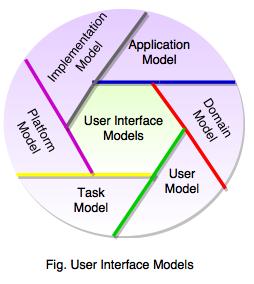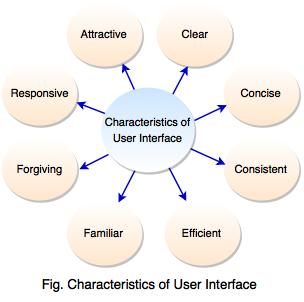Characteristics of User Interface
User interface development process is the development of mobile applications or web applications, websites and software development.
This process plays a key role in the SDLC (Software Development LifeCycle).
The main goal of user interface design is to make the user’s interaction as simple and efficient as possible, in terms of achieving the user goals.
To get in depth knowledge on UI, enrich your skills on online ui training Course
user interface development process
The above diagram shows the development process of user interface. It includes four phases:
-
Analysis
-
Design
-
Implementation
-
Testing
-
Analysis
User interface analysis focuses on user, task, content and work environment interacted with the system.
Analysis defines the human and computer oriented tasks required to achieve the system functions. -
Design
Interface design defines a set of interface objects, actions and screen representations that enable a user to perform all defined tasks in a manner which meets every usability objective defined for the system.
Design phase includes following terms:
I. Functional requirements determines the initial requirements and goals for the application.
II. User analysis identifies the user scenarios and understand the needs and expectations of users for each scenario.
III. Conceptual design models the underlying business that the application must support.
IV. Logical design processes the design and information flow of the application.
V. Physical design decides how the logical design will be implemented on specific physical platforms.Get more industrial skills from UI Training
- Implementation
Interface implementation focuses on the ability of the user interface to implement every user task correctly to achieve all general user requirements.
Implementation prototype focuses on the interface and cannot include distracting visual design elements.
Implementation constructs the application and prepare for design change requests. - Testing
Testing determines the effectiveness of an UI application that must be tested and exposes how easy or difficult the UI is to use for the broadest possible audience.
Testing focuses on two types of testings:
-
Usability testing
-
Accessibility testing
-
Usability testing evaluates a product by studying how real users actually use the system. It provides significant payback only when it is well integrated into the entire project lifecycle.
-
Accessibility testing accesses the test application with accessible technologies and automated test tools.
User Interface Models
- User interface models are used to analyzed and designed the user interface.

- Following figure shows the different models of user interface:
- user interface models
- Domain Model
Domain model is implemented as an object model within a layer which describes aspects of knowledge or activity.
This model is a representation of meaningful real-world concepts to the domain that need to be modeled in software.
It is used to solve problems related to domain. - User Model
User model represents the different features of end users and the roles they are playing within the organization. - Task Model
Task model describes the tasks of an end user which performs and dictates what type of interaction capabilities must be designed.
This model is the logical description of the activities and used for designing, analyzing and evaluating interactive software applications. - Platform Model
Platform model is used to model the physical devices intended to host the application and defines how they interact with each other. - Implementation Model
Implementation is a representation of how a system actually works and reflected in every interface element.
This model is created by the software implementers who work on look and feel of the interface combined with all supporting information which describes the system syntax. - Application Model
Application model performs a group of coordinated functions, tasks or activities for the benefit of the user.
It refers to all applications involved with running the computer.
To start a career with UI (User Interface), Please go through the link online ui training course
#online ui training #ui training #ui design course #ui ux course
